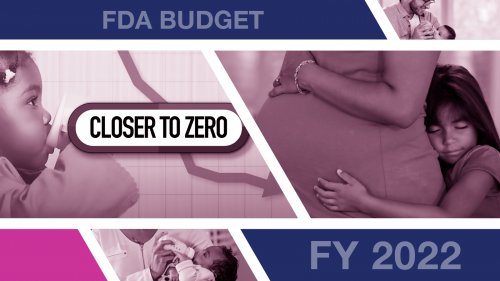FDA’s Budget: Maternal and Infant Health and Nutrition

By: Janet Woodcock, M.D., Acting Commissioner of Food and Drugs
Nutrition during pregnancy and in early childhood is critically important in supporting the health and wellbeing of mothers and their children. The U.S. Food and Drug Administration’s food and nutrition programs are well-positioned to make progress in maternal and infant health and nutrition this year, and will invest across the centers and offices involved in its foods program to make improvements in key areas related to food safety and nutrition.
The investments outlined in the FDA’s FY 2022 budget request include important funding to core food safety programs that require significant investments to address unmet public health funding needs, as well as emerging issues of concern. One of those areas is maternal and infant health and nutrition. Some of the food safety investments include bolstering the funding provided to programs that are responsible for maternal and infant nutrition and providing much needed additional funds to address numerous emerging food-related chemical and toxicological issues.
Specifically, the FY 2022 Budget requests $22 million — an increase of $18.0 million above the FY 2021 enacted level— for the FDA’s Center for Food Safety and Applied Nutrition (CFSAN) to take regulatory and other actions to address toxic elements in baby food, improve the currently limited staff review capacity for premarket review of infant formula submissions to evaluate the safety and nutritional adequacy of infant formula, and nutrition work specific to infants, toddlers, and pregnant and lactating women, and educate consumers on the new Dietary Guidelines Americans’ recommendations for pregnant and lactating women and early childhood.
Closer to Zero Action Plan
In April, the FDA announced “Closer to Zero”— the agency’s action plan for reducing exposure to toxic elements, including lead, arsenic, cadmium, and mercury, from foods for babies and young children. Our plan describes the approach we will take to help continually reduce toxic elements to the lowest levels possible in foods eaten by babies and young children.
Reducing exposure to toxic elements—especially for babies and children—is one of the FDA’s highest priorities. Our goal of moving us closer to zero exposure to toxic elements from foods reflects our commitment to take significant steps to help reduce contamination. However, because fruits, vegetables, and grains can ‘take up’ toxic elements in the environment from the water, soil, and air, there are limits to how low the levels can be reduced. Exposure to toxic elements depends on the levels of the elements found in foods as well as the amount of the food consumed.
During the first year (Phase 1), the agency is committed to:
- Proposing action levels for lead in categories of foods consumed by babies and young children.
- Consulting with and gathering data from stakeholders and federal partners on issues such as feasibility and best practices.
- Evaluating the science related to arsenic exposure from foods.
- Sharing resources with industry on best practices for reducing or preventing lead contamination.
- Completing updated sampling assignments that will look at toxic element levels in baby foods.
The subsequent phases of this plan will include addressing additional toxic elements such as cadmium and mercury. As new data, information, and resources become available, we will continue the cycle of continual improvement, addressing each toxic element in its turn.
Recruiting Risk and Data Analysts, Consumer Safety Officers, Toxicologists and Chemists
With additional resources, CFSAN will recruit risk analysts, consumer safety officers, data analysts, public health information specialists, toxicologists, and chemists among others. Increased staffing in these areas will allow CFSAN to expand research on co-occurrence of toxic elements in baby foods and impacts on neurodevelopment, and evaluate how changes to laboratory procedures and adjustments to existing analytical methods, for certain foods, would improve industry’s ability to detect levels of concern.
Increased resources will also allow CFSAN to create risk communication and education materials for consumers on the risks from toxic elements in foods, and the importance of healthy dietary patterns and variety as a strategy for reducing toxicants in the diet. The resources would also allow CFSAN to develop additional education and outreach materials for industry that outline strategies and approaches for managing and minimizing the presence of toxic elements in their products. CFSAN also seeks additional resources to expand agency capacity to review the increasing number, size, and complexity of infant formula submissions.
Nutrition for Infants, Toddlers and Pregnant and Lactating Women
The health and well-being of mothers, infants, and children is critical – additional resources will allow CFSAN to make progress in this important area. The agency plans to establish reference levels for exposure to toxic elements from foods; set expectations to strive for continual improvement; and provide action levels for lead, arsenic, cadmium, and mercury for different categories of foods consumed by babies and very young children, with the goal that they will decrease over time if new technologies, interventions or science become available. The FDA will also partner with the U.S. Department of Health and Human Services’ Office of Disease Prevention and Health Promotion, the U.S. Department of Agriculture, and others, to explore opportunities to better help educate consumers on the Dietary Guidelines for Americans’ recommendations for pregnant and lactating women and early childhood while also reducing dietary exposure to toxic elements.
The FDA is uniquely positioned to address these critical areas, and meaningful progress will be accelerated by an infusion of new resources to perform this work. Toxic metals such as lead, arsenic, mercury, and cadmium are present in air, water, and soil, so some exposure through food is unavoidable, but exposure for infants and young children could potentially be reduced. These actions can also work to advance health equity. Improving awareness of how to achieve healthy dietary patterns while reducing toxic elements during pregnancy and for infants and young children is likely to benefit to a greater degree certain racial, ethnic and socioeconomic subgroups, who may be at increased risk for nutrition-related chronic diseases.
We will update the public on other key FDA budget priorities in future FDA Voices and look forward to continuing to work with Congress to ensure the FDA has the resources it needs to carry out our vital public health mission to protect and promote the public health.

